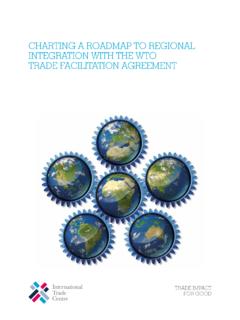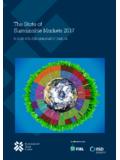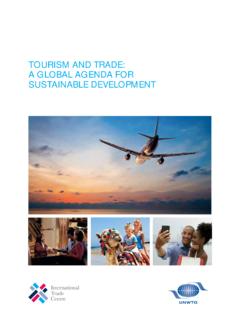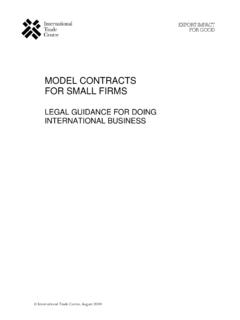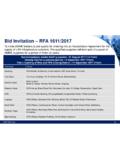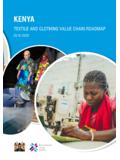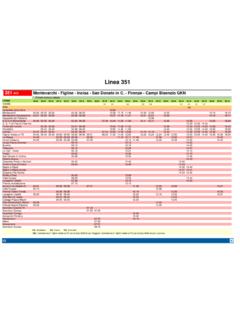Transcription of ETHIOPIA - International Trade Centre
1 ETHIOPIA . TEXTILE AND CLOTHING VALUE CHAIN ROADMAP. 2016-2020. TEXTILE & CLOTHING VALUE CHAIN ROADMAP OF ETHIOPIA . TEXTILE & CLOTHING. VALUE CHAIN ROADMAP OF ETHIOPIA . This value chain roadmap was developed on the basis of the process, methodology and technical assistance of the International Trade Centre ( ITC ) within the framework of its Trade Development Strategy programme. ITC is the joint agency of the World Trade Organization and the United Nations. As part of the ITC. mandate of fostering sustainable development through increased Trade opportunities, the Export Strategy section offers a suite of Trade -related strategy solutions to maximize the de- velopment payoffs from Trade . ITC-facilitated Trade development strategies and roadmaps are oriented to the Trade objectives of a country or region and can be tailored to high-level economic goals, specific development targets or particular sectors, allowing policymakers to choose their preferred level of engagement.
2 The views expressed herein do not reflect the official opinion of ITC. Mention of firms, products and product brands does not imply the endorsement of ITC. This document has not been formally edited by ITC. The International Trade Centre ( ITC ). Street address : ITC, 54-56, rue de Montbrillant, 1202 Geneva, Switzerland Postal address : ITC Palais des Nations 1211 Geneva, Switzerland Telephone : + 41- 22 730 0111. Postal address : ITC, Palais des Nations, 1211 Geneva, Switzerland Email : Internet : http :// w Layout: Jes s Al s v ACKNOWLEDGMENTS. This value chain roadmap was elaborated as a component of the ITC Supporting Indian Trade and Investment in Africa ( SITA ) project, a south-south Trade and in- vestment initiative that aims to improve the competitiveness of select value chains through the provision of partnerships by institutions and businesses from India.
3 SITA. is funded by the United Kingdom Department for International Development ( DFID ). The formulation of the value chain roadmap was led by the Ethiopian Textile Industry Development Institute ( ETIDI ) and the Ethiopian Textile and Garment Manufacturers Association ( ETGAMA ) with the technical assistance of ITC. This document repre- sents the ambitions of the private and public sector stakeholders for the develop- ment of the sector. Stakeholders' commitment and comprehensive collaboration have helped build consensus around a common vision that reflects the realities and limitations of the private sector, as well as of policymakers and Trade -related institutions. The document benefited particularly from the inputs and guidance provided by the members of the sector team.
4 Name Organization Position Ethiopian Textile Development Mr. Sileshi Lemma Institute Director General Ethiopian Textile and Garment Mr. Fassil Tadesse Manufacturers Association President Ethiopian Cotton Producers Mr. Asefa Aga Ginners Exporters and Association General Secretary Miss. Aberash Alemu South Region TVET Bureau Training Materials Supply Head Mr. Goshu Negash Vitcon Plc General Manager Mr. Mustefa Jemal Kombolcha Textile General Manager Mr. Addisu Fulli Welkite University Engineering College Dean Addisu Ferede (Asst. Ethiopian Institute of Textile and Professor) Fashion Technology Scientific Director Mr. Eyob Beklele Desta Garment Plc General Manager Mr. Mohammed Umer Novastar Garment Factory Plc General Manager Mr.
5 Kehase G/michel Federal TVET. Ethiopian Textile Development Cotton and Textile Marketing Directorate Mr. Yared Mesfin Institute Director Ethiopian Textile Development Mr. Yitbarek Tilahun Institute Ginning and Spinning Directorate Director Technical support and guidance from ITC was rendered through Eric Buchot, Alexandra Golovko, Olivier Marty, Hanna Bucher, Varun Vaid, Robert Kafafian, Carla Vaca and Carlos Griffin. Assefa Yohannes and Genzeb Akele Zewdie both provided valuable support as national SITA coordinators. vi CONTENTS. EXECUTIVE SUMMARY XII. GLOBAL TRENDS 2025 LIVING THROUGH A TRANSFORMATIVE PERIOD 17. THE ONLY CONSTANT IS CHANGE 17. TEXTILES AND APPAREL IN ETHIOPIA : AN INDUSTRY OF GREAT PROMISE 23.
6 A SECTOR IN FULL BLOOM AND ON THE VERGE OF FULL VALUE CHAIN INTEGRATION 23. STRATEGIC ISSUES AND COMPETITIVE CONSTRAINTS 35. Supply side issues 37. Business environment issues 42. Market entry issues 45. Socio-economic and environment issues 46. STRATEGIC IMPLICATIONS FOR THE VALUE CHAIN ROADMAP 48. THE WAY FORWARD 49. THE STRATEGIC OBJECTIVES 51. LEVERAGING MARKET OPPORTUNITIES 53. INVESTMENT TARGETING FOR SUSTAINABLE EXPORT GROWTH 55. FUTURE VALUE CHAIN 58. I. Foreseen adjustments in the textile segment 60. II. Greater value addition in the garment segment as well as market and product diversification 61. III. Further development and integration of industrial zones 61. IV. Enhanced support services, particularly in the areas of TVET, quality management, finance and logistics 62.
7 MOVING TO ACTION 62. THE PLAN OF ACTION 65. REFERENCES 86. APPENDICES 89. vii FIGURES. Figure 1 : Trend towards greater value addition 18. Figure 2 : ETHIOPIA 's T & C value chain 25. Figure 3 : Ginning outturn of selected African countries ( 2013 ) 26. Figure 4 : Cotton lint production in ETHIOPIA , 1940 / 41 to 2010 / 11 27. Figure 5 : ETHIOPIA 's T & C exports, 2001 2014 ( US $ thousands ) 33. Figure 6: ETHIOPIA 's Trade in clothing products, 2001 2014 (US$ thousands) 33. Figure 7 : ETHIOPIA 's Trade in textile products, 2001 2014 ( US $ thousands ) 34. Figure 8 : The way forward 49. Figure 9 : Projections of ETHIOPIA 's apparel export growth 50. Figure 10 : ETHIOPIA 's T & C future value chain 59. APPENDICES.
8 Figure 1 : Decomposition of ETHIOPIA 's export growth of garments and textiles, 2004 2013 96. Figure 2 : Probability of export survival, 2002 2014 96. Figure 3 : Contribution to ETHIOPIA 's clothing Trade deficit, 2014 97. Figure 4 : Top importers of Ethiopian garments, 2001 2014 ( US $ thousands ) 97. Figure 5 : Contribution to ETHIOPIA 's textiles Trade deficit ( 2014 ) 99. Figure 6 : Top importing markets for Ethiopian textiles, 2001 2014 ( US $ thousands ) 99. TABLES. Table 1 : Top exporters of clothing, 2003-2013 20. Table 2 : Top exporters of textiles, 2003-2013 20. Table 3 : Comparison of costs and competitive factors between ETHIOPIA and competitors 31. Table 4 : ETHIOPIA 's top 5 textile exports, 2009 and 2014 ( US $ thousands ) 35.
9 Table 1 : ETHIOPIA 's top 10 exported garments, 2009 2014 ( US $ thousands ) 98. Table 2 : Top changes in market share by product 98. Table 3 : ETHIOPIA 's top 10 textile exports, 2009 2014 ( US $ thousands ) 100. APPENDICES. Table 1 : Potential investors based in India 101. Table 2 : Potential prospects in target markets 102. Photo: Kara Newhouse, Textile Factory. ACRONYMS. The following abbreviations are used : ACTIF African Cotton and Textiles Industries Federation MLS SCM Modular Learning System Supply Chain AGOA African Growth and Opportunity Act Management CAGR Compound Annual Growth Rate MoFED Ministry of Finance and Economic Development CMT Cut, Make & Trim MoU Memorandum of Understanding COMESA Common Market for Eastern and Southern Africa MRA Mutual Recognition Arrangement CSR Corporate Social Responsibility MSME Micro, Small and Medium-Sized Enterprise EAC East African Community NID National Institute of Design ( India ).
10 ECAE Ethiopian Conformity Assessment Enterprise NIFT National Institute of Fashion Technology ( India ). ECPGEA Ethiopian Cotton Producers, Exporters and NMI National Metrology Institute of ETHIOPIA Ginners Association OECD Organisation for Economic Co-operation and EC EQM Enterprise Competitiveness ( section of ITC ) Development Export Quality Management PoA Plan of Action EC SCM Enterprise Competitiveness ( section of ITC ) PPP Public Private Partnership Supply Chain Management REACH Registration, Evaluation, Authorization EIA Ethiopian Investment Agency and Restriction of Chemicals EIC Ethiopian Investment Commission SADC Southern African Development Community EIIDE Ethiopian Industrial Inputs Development Enterprise SC Sector Competitiveness ( section of ITC ).

